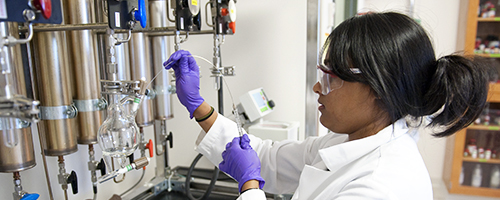Document Type
Article
Publication Date
3-18-2011
Publication Title
Accounts of Chemical Research
Abstract
Named organic reactions. As chemists, we’re all familiar with them: who can forget the Diels−Alder reaction? But how much do we know about the people behind the names? For example, can you identify a reaction named for a woman? How about a reaction discovered or developed by a woman but named for her male adviser? Our attempts to answer these simple questions started us on the journey that led to this Account.
We introduce you to four reactions named for women and nine reactions discovered or developed by women. Using information obtained from the literature and, whenever possible, through interviews with the chemists themselves, their associates, and their advisers, we paint a more detailed picture of these remarkable women and their outstanding accomplishments.
Some of the women you meet in this Account include Irma Goldberg, the only woman unambiguously recognized with her own named reaction. Gertrude Maud Robinson, the wife of Robert Robinson, who collaborated with him on several projects including the Piloty−Robinson pyrrole synthesis. Elizabeth Hardy, the Bryn Mawr graduate student who discovered the Cope rearrangement. Dorothee Felix, a critical member of Albert Eschenmoser’s research lab for over forty years who helped develop both the Eschenmoser−Claisen rearrangement and the Eschenmoser−Tanabe fragmentation. Jennifer Loebach, the University of Illinois undergraduate who was part of the team in Eric Jacobsen’s lab that discovered the Jacobsen−Katsuki epoxidation. Keiko Noda, a graduate student in Tsutomu Katsuki’s lab who also played a key role in the development of the Jacobsen−Katsuki epoxidation. Lydia McKinstry, a postdoc in Andrew Myers’s lab who helped develop the Myers asymmetric alkylation. Rosa Lockwood, a graduate student at Boston College whose sole publication is the discovery of the Nicholas reaction. Kaori Ando, a successful professor in Japan who helped develop the Roush asymmetric alkylation as a postdoc at MIT. Bianka Tchoubar, a critically important member of the organic chemistry community in France who developed the Tiffeneau−Demjanov rearrangement.
The accomplishments of the women in this Account illustrate the key roles women have played in the discovery and development of reactions used daily by organic chemists around the world. These pioneering chemists represent the vanguard of women in the field, and we are confident that many more of the growing number of current and future female organic chemists will be recognized with their own named reactions.
Volume
44
Issue
5
First Page
311
Last Page
321
DOI
0.1021/ar100114m
Rights
“This document is the Accepted Manuscript version of a Published Work that appeared in final form in Accounts of Chemical Research, copyright © American Chemical Society after peer review and technical editing by the publisher. To access the final edited and published work see [insert ACS Articles on Request author-directed link to Published Work, see http://pubs.acs.org/doi/abs/10.1021/ar100114m
Version
Author's Accepted Manuscript
Recommended Citation
Olsen, Julie A. and Shea, Kevin M., "Critical Perspective: Named Reactions Discovered and Developed by Women" (2011). Chemistry: Faculty Publications, Smith College, Northampton, MA.
https://scholarworks.smith.edu/chm_facpubs/11


